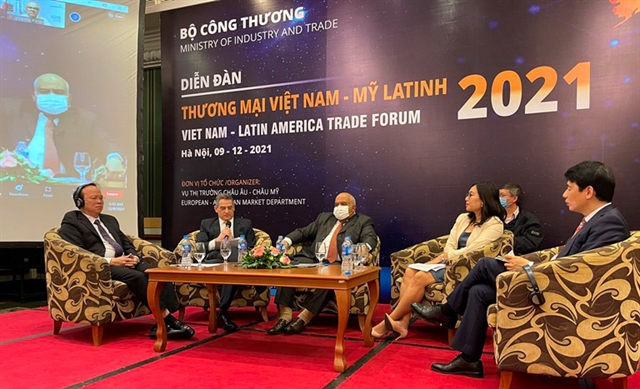 Economy
Economy


|
| The Việt Nam - Latin America Trade Forum 2021 was held in Hà Nội on December 9. |
HÀ NỘI - The trade value between Việt Nam and Latin America is expected to increase to US$20 billion by 2025, Deputy Minister of Industry and Trade Đỗ Thắng Hải said that at the Việt Nam - Latin America Trade Forum 2021, held in Hà Nội on December 9.
Việt Nam has trade relations with all 33 countries in the region, with a total bilateral trade value of US$15.6 billion in 2020, an increase from US$245 million in 2000. Việt Nam's exports are worth US$8.3 billion and imports US$7.3 billion.
An advantage in trade relations with Latin America is that Việt Nam has also signed many free trade agreements (FTAs) with a number of countries in the region, especially the FTA with Chile, and the CPTPP with Mexico, Chile and Peru.
Those agreements are considered an important factor in promoting trade and investment cooperation between Việt Nam and other countries in the region.
Việt Nam expects to attract investment of about US$12-13 billion from Latin America by 2025, according to Hải.
Việt Nam has had a number of investment projects in Latin America, with a total capital of hundreds of millions of US dollars, such as projects on developing telecommunications networks in Haiti and Peru, and producing instant noodles in Brazil.
Meanwhile, 27 countries and territories in Latin America have put a total registered investment capital of US$9.3 billion into 297 projects in Việt Nam.
"Việt Nam expects to increase trade value and investment with countries in the region, especially in fields of energy, telecommunications, high-tech agriculture and industries with value-added products," Hải said.
At the forum, Mexican Economy Minister Tatiana Clouthier Carrillo highlighted a number of investment and trade fields that Vietnamese businesses could focus on in the future.
“The CPTPP has come into effect, promoting investment and trade between Việt Nam and Mexico with many incentives. Mexico is interested in the ability of cooperation between production centres of the two countries to help the two countries join into global value chains in North America and South East Asia,” she said.
“Mexico also encourages Việt Nam’s suppliers to participate in its value chains in sectors of electric cars, electronic products and aerospace."
Nguyễn Cẩm Trang, deputy director of the Import-Export Department (Ministry of Industry and Trade), said that incentives from trade agreements could mean high growth for Việt Nam's exports to Latin American countries.
However, the businesses of the two sides still face challenges, including the long distance between the two countries and no direct routes for transporting goods and passengers, which create long transport times and high costs. In addition, the severe impact of the COVID-19 pandemic in the past two years has disrupted global supply chains, according to Trang.
To increase exports to this market, local enterprises need to improve their competitiveness and meet the requirements of product quality.
Director of MoIT European and American Market Department Tạ Hoàng Linh said that to increase exports to these markets, Vietnamese enterprises needed to assess their demand and competitive advantages as well as carefully study the regulations on import of goods, taxes and customs procedures.
“The ministry and its trade offices in Latin American countries will provide market information for localities and the Vietnamese business community and act as a bridge with foreign partners,” Linh said. “The ministry will also assist them in solving difficulties and obstacles in the process of market penetration and business."
Amazon Global Việt Nam said the pandemic had changed the buying habits of customers as they switched to shopping online.
Vietnamese businesses should seize the opportunity to develop e-commerce activities with Latin American markets, especially retailers.
In the past, it was difficult for Việt Nam to bring goods to this region, but now with e-commerce, they could easily offer goods to this market if their products have a brand name and code.
Cultural differences and distant geography are barriers for Vietnamese companies to access the Latin American market. They need to study it carefully, according to Amazon Global Việt Nam. VNS